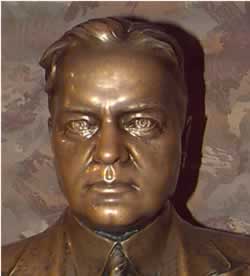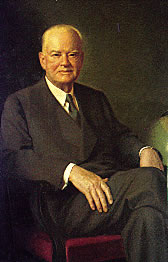==
Hoover Dam
Herbert Hoover & the Colorado River
The Man
 Herbert Hoover, 31st President of the United
States, was a man of many interests. He was an engineer, a conservationist, a
fisherman, a humanitarian, and a politician, not always in the same order. The
great dam which bears his name, spanning the Colorado River to link Nevada and
Arizona, stands as an enduring testimony to all of these characteristics.
Herbert Hoover, 31st President of the United
States, was a man of many interests. He was an engineer, a conservationist, a
fisherman, a humanitarian, and a politician, not always in the same order. The
great dam which bears his name, spanning the Colorado River to link Nevada and
Arizona, stands as an enduring testimony to all of these characteristics.
His years of service, both as a public official and a private citizen, reflected his lifelong passion for the outdoors and the preservation of this nation's natural resources. Characteristically, this was often expressed whimsically in what Hoover called the democracy of fishing. "All men are created equal before fishes," he explained.
Early in his public career he gained widespread recognition as a conservationist. In 1922, barely a year into his tenure as Warren G. Harding's Secretary of Commerce, Hoover had already stirred environmental enthusiasm for harnessing rivers for flood control, increasing the production of fisheries, and cleaning up rivers and harbors. He spoke out before Congress in support of these and related natural resources protection issues which were then and are now -- major concerns of the Reclamation program.
Hoover reiterated his support for vigorous action to safeguard the environment in a 1924 telegram to former U.S. Senator J.S. Frelinghusen of New Jersey. "I cannot state too strongly that pollution of waters under Federal control is destroying not only our fisheries, but is also destroying our beaches and endangering our harbors ..." he asserted.
The Great Engineer
Hoover's aggressive commitment to pollution-free streams, clean beaches, and unspoiled harbors also extended to flood control. When the Mississippi River roared over its banks in 1927, laying waste to thousands of acres of agricultural land, Hoover rushed to the scene to offer help. Known early in his career as "The Great Engineer," he was now popularized as "The Great Humanitarian." His relief efforts in America's stricken heartland foreshadowed a series of dams and locks built by the Federal government to avert similar disasters in the future.
But the centerpiece of Hoover's campaign for flood control, river management, and generation of hydroelectric power was the Bureau of Reclamation's Boulder Canyon Project. Throughout recorded history, the Colorado River had caused devastation on a regular basis. Each spring the Rocky Mountains supplied a cascade of newly melted snow. Rushing to the Gulf of California unchecked, the torrent posed special dangers for the Imperial Valley of southeastern California. A particularly devastating flood hit the lower river in 1905 causing the Colorado to change course and flow uncontrolled into the Imperial Valley for more than a year. The result was the creation of the Salton Sea.
The Visionary Statesman
 As a resident of California, Herbert Hoover had visited
the Lower Colorado region often in the years before World War I. He was familiar
with both its problems and its potential for development. So it came as no
surprise that, upon becoming Secretary of Commerce in 1921, one of Hoover's
earliest proposed initiatives was the construction of a high dam in Boulder
Canyon. In addition to essential flood control, the dam would make possible the
expansion of irrigated farming in the parched region. It would also provide a
dependable supply of water for Los Angeles and other Southern California
communities. As envisioned by Secretary Hoover, the project would be
self-supporting, financed entirely through the sale of hydroelectric power
generated at the dam.
As a resident of California, Herbert Hoover had visited
the Lower Colorado region often in the years before World War I. He was familiar
with both its problems and its potential for development. So it came as no
surprise that, upon becoming Secretary of Commerce in 1921, one of Hoover's
earliest proposed initiatives was the construction of a high dam in Boulder
Canyon. In addition to essential flood control, the dam would make possible the
expansion of irrigated farming in the parched region. It would also provide a
dependable supply of water for Los Angeles and other Southern California
communities. As envisioned by Secretary Hoover, the project would be
self-supporting, financed entirely through the sale of hydroelectric power
generated at the dam.
A plan so ambitious carried built-in pitfalls aplenty. For many years, water rights had been a source of litigation involving the states that were within the Colorado River Basin, Arizona, California, Colorado, Nevada, New Mexico, Utah and Wyoming. Under Hoover's prodding, the Colorado River Commission was formed to reach an equitable resolution of these interstate claims. As chairman of this group, Hoover met in January 1922, with state governors and other representatives in hopes of speeding an agreement.
Following a series of meetings throughout the seven-state region, commission members assembled in Santa Fe, New Mexico. They sat 10 hours a day for two weeks, deadlocked over the division of water rights and usage of the flows of the river. It was then that Secretary Hoover proposed to split the river basin into two regions: "Upper Basin States" and "Lower Basin States," with the water divided between them. This was the Hoover compromise.
The division of water among the individual states of each basin would be left for future agreement. The resulting agreement, signed on November 24, 1922, became known as the Colorado River Compact. Assuming approval of the pact by the legislatures of the involved states, Hoover's compromise would pave the way for construction of the great dam on the Colorado.
Realization of a Dream
In time, President Calvin Coolidge endorsed legislation authorizing construction of the dam. Before it could take effect, however, Coolidge made way for a new occupant of the Oval Office. On June 25, 1929, President Herbert Hoover signed a proclamation making the Colorado River Compact effective at last.
In a press conference that same day, President Hoover hailed the long delayed breakthrough. The new compact, he said, represented "the final settlement of quarrels that have extended over 25 years ... the most extensive action ever taken by a group of states under the provisions of the Constitution permitting compacts between states." Hoover welcomed the agreement as evidence that Washington could play the role of umpire for a Federal team dominated by state governments.
On September 17, 1930 Secretary of the Interior Ray Lyman Wilbur, following national custom, announced that the new dam on the Colorado River would be named Hoover Dam to honor the then President of the United States. Later, the names Boulder Dam and Boulder Canyon Dam would be used. The name Hoover Dam was restored by Congress in 1947.
In November, 1932, while en route to Washington from California after his election loss to Franklin D. Roosevelt, President Hoover ordered a last-minute change in itinerary to make a brief stop at the dam construction site outside Boulder City, Nevada. After noting his many previous visits to the area, Hoover sounded almost lyrical in paying tribute to the dam's builders. "It is giving long held taking form in actual reality of stone and cement," he remarked with obvious emotion. "The waters of this great river, instead of being wasted in the sea, will now be brought into use by man. Civilization advances with the practical application of knowledge in such structures as the one being built here in the pathway of one on the great rivers of the continent. The spread of its values in human happiness is beyond computation."
Since Herbert Hoover last gazed upon the dam bearing his name, countless visitors have shared his awe at the Eighth Wonder of the Modern World. A credit to "The Great Engineer."
Source - U.S. Department of the Interior - Bureau of Reclamation